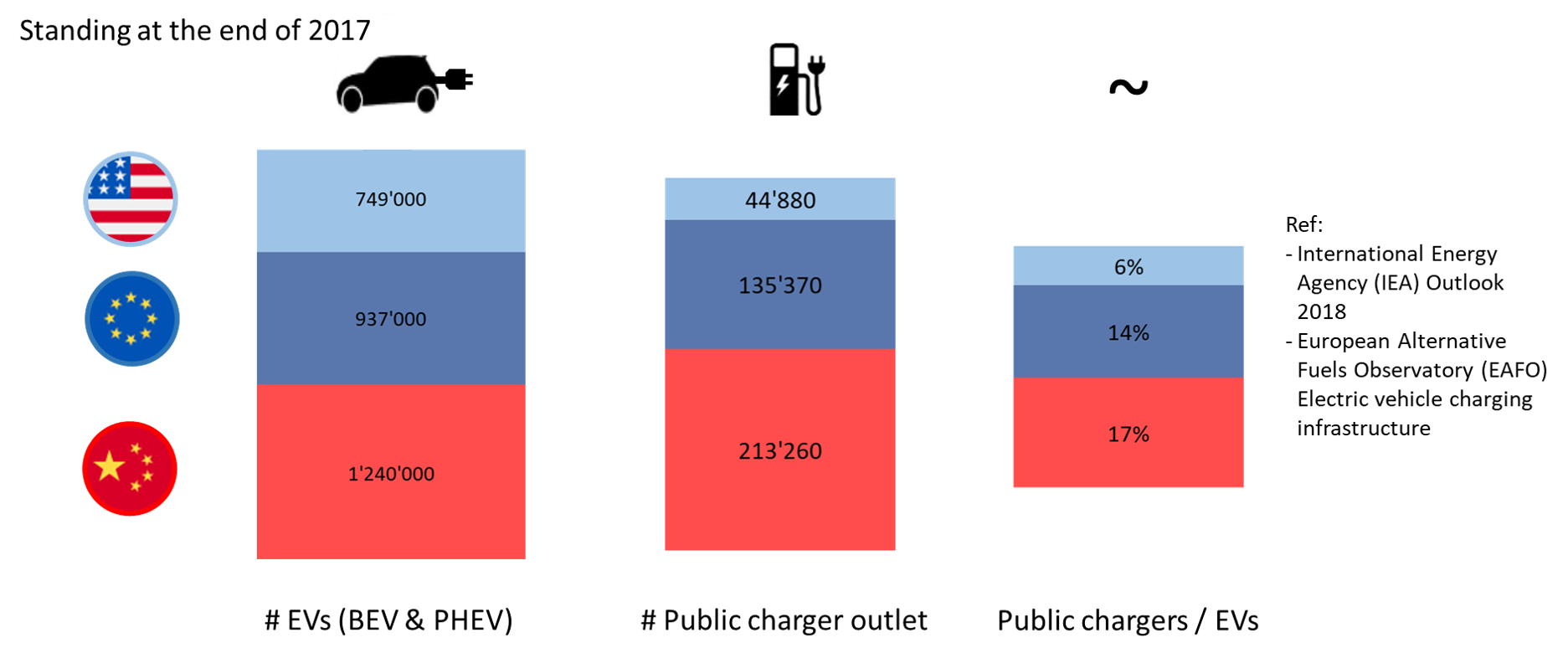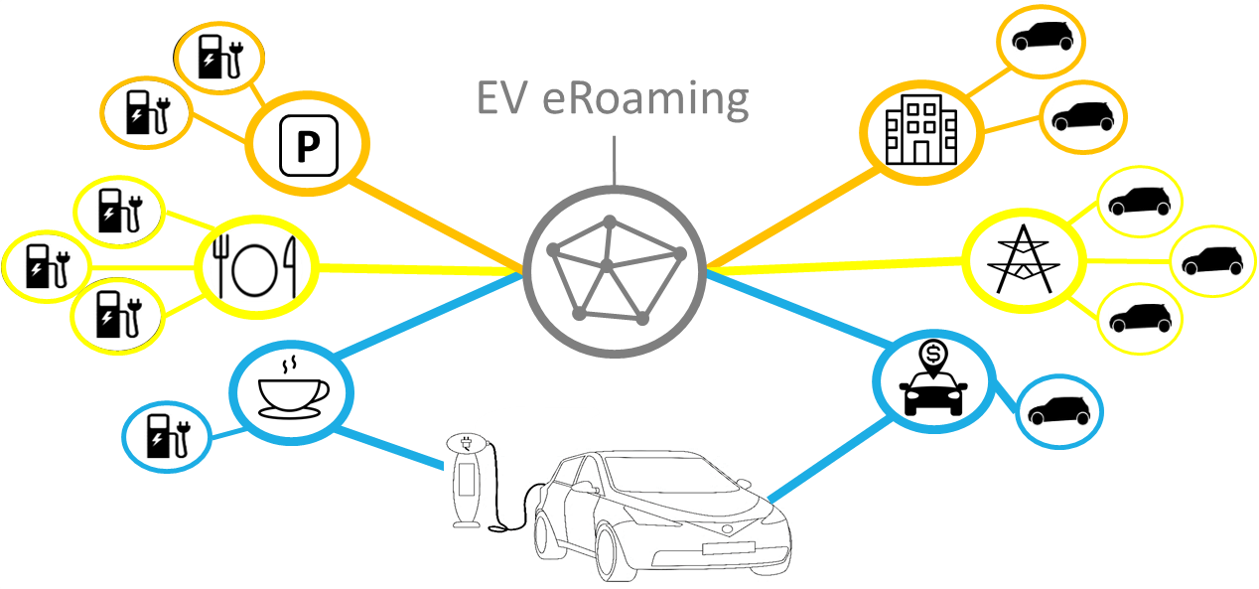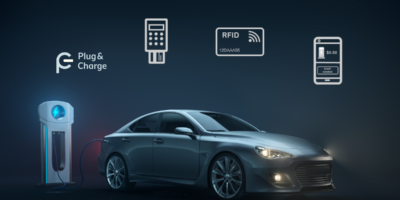Electric vehicles registrations are growing all over the world but what is happening in the US? I had the opportunity to live the last 4 months in North Carolina and observe this market from inside. In the most populated car country in the world with 910 vehicles per 1,000 ppl, charismatic EV companies (e.g. Tesla), high living standards and low energy costs, it is obvious that the United States is the ideal place for electric cars! Let’s get a view of the situation and what could be done to accelerate this tendency.
What is the current situation?
At the end of 2017, the US represented the 3rd biggest electric vehicle market with 749,000 EVs on the road. However, in terms of adoption, the US has only 0.6% market share and fall below many other developed countries. This is concerning if we consider that the State of California alone represents 49% of US EV registrations (ref. icct). The Gold Coast is even considered as the 5th most populated electric vehicle region in the world! It is therefore not a surprise to see major EV Head Quarters based there.

What is slowing down the adoption of Electric vehicles?
There are 3 main areas which can influence the adoption of EVs:
- Suitable electric vehicles
- High availability of public charging stations
- Favourable government policies
Are Electrical vehicles suitable for the American market?
The USA is the land of big engines! Good news, electric vehicles are enormously powerful! I invite you to test drive an EV and compare it with a muscle car. I did this experience and I can tell you that a Tesla S is closer to a Dodge Charger than a small hatchback, except that it is silent and efficient!
EV challenges are rather expensive prices, limited driving ranges and poor model variety. With a driving range of 150 to 300-miles, EVs are ideal for daily commutes but aren’t suited for weekend getaways. We should also consider that Americans travel on average 13,476 miles per year (according to FHWA) which is almost twice the distance than Europeans do. Another problem is the poor choice of vehicle categories to fulfil the needs of families or sports enthusiasts with missing SUVs, Vans or Pickups. Even if the running costs makes you save money in the long run, there are nearly no cars below $35,000.
Lack of charging stations
Public or commercial charging stations are essential to travel across the country. As we can read in the graph above, the US with 44,880 charger outlet (sockets) is way below China and Europe. Especially if we consider the ratio of charger outlet per EVs. This is partly due to the wide territory and the low density of the country (Only 92 residents per square miles) which makes it harder for a national coverage. A high density would also guarantee more charging frequencies to amortize electric vehicle supply equipment (EVSE).

There are sometimes few or no charging stations between two cities.
No interconnection between charging networks
There is currently no interconnection of charging networks. It means that drivers have to subscribe to almost 5 networks or use other payment systems to charge anywhere. The problem is due to a concept of closed subscriptions networks from current eMobility providers (EMP). What is obvious in the banking sectors with ATM serving any types of debit cards isn’t yet with public chargers. Now, let’s imagine the level of stress travelling and depending on only 1 charging station with no guarantee that you can access it, is in service or at least not busy!
Ambivalent Government policies but great States organisations
Let’s be honest the decision to freeze the fuel efficiency standards (greenhouse gas emissions standards) from the current US government is not positive for the adoption of EVs but it won’t affect global carmaker objectives. Indeed, Toyota and Mercedes R&D develop engines for the world. It means that they have to cope with severe European and Chinese CO2 constraints which represent together 60% of the worldwide automotive market. These electrified low consuming cars are going to be sold in the US and it would be naïve to think that consumers would choose “high gasoline” options…
On the other hands, there are great state-wise programmes such as Plug-in NC in North Carolina which is actively promoting electric vehicles and bringing market players and consumers together. The idea is to educate and integrate electrified vehicles into communities.
What could accelerate the adoption of electric vehicles?
The enormous US potential with 113 million registered automobiles with positive forecasts of 30% EV sales by 2030 (IAE EV30@30 initiative) will automatically attract plenty of investors! Let’s see how these investments could push the development of competitive electric vehicles and charging station availabilities.
Electric vehicle market: Embrace changes!
Ford and GM switching gears
After a slow start, the US automotive market leaders, GM and Ford have announced the rollout of 20 to 40 electrified vehicles by 2023!
Chinese aggressive move
Who would drive a Chinese car today? Let’s be honest, not many, but they are the biggest battery producers and are investing massively in cost-effective EVs (e.g. BYD) motors. These cars are almost batteries on wheels! After all, everyone seems to be happy with their “assembled in China” iPhones.
Electric cars getting cheaper
High production of cars and constant battery cost reduction are pushing prices of EVs down. I believe that in 5 years’ time, they could even match gasoline cars.
Charging station Networks: Get more market players!
Let’s start with the Electrify America project with 2 Billion investments in zero-emission equipment, thanks to the VW Diesel settlement. That’s great but the success of charging networks can only be ensured with more competition among industry actors!
New business model for market entrant
Most of the charging stations have been installed and operated by specialised service providers managing charging revenues. This model is hardly financially viable due to high service-costs for parking owners. As a consequence, the scalability of further charger investments is limited. To reverse this tendency, we need to enable new market players such as utilities, big retailers or carmakers to become service providers instead of resellers (see industry role post). This is possible thanks to cloud-based service platforms with open protocols (OCPP) working with any type of charging hardware. Skipping intermediaries will ensure more profitability and get more investments in charging facilities.
Open and interconnected charging station networks
Any EV drivers should be able to charge anywhere with one subscription service! This is possible with eRoaming solutions connecting Driver eMobility Providers (EMP) with charging station operators (CSO). This is already standard in Europe and allows more charging opportunities for EV drivers and parking owners!

Finally, let’s change the image and get away from the “green”
Insisting on the renewable aspect of these automobiles isn’t necessary anymore and could be even contra productive. It doesn’t give justice to power, efficiency and economic benefits of these electric cars. We should rather advertise the opportunity to be independent with self-sufficient solar (PV) energy production.
All ingredients are here to make USA great in electric vehicle adoptions! Are YOU ready?
References:
– International Energy Agency (IEA) Global EV Outlook 2018
– European Alternative Fuels Observatory (EAFO) Electric vehicle charging infrastructure





Leave a Reply